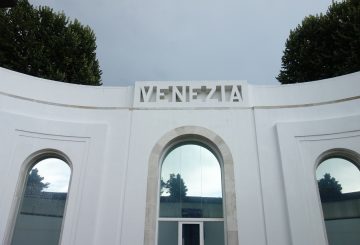Flags fluttered along Macquarie Street down to the Opera House, the brightly coloured banners read like a who’s who of contemporary art, Warhol, Freud, Sherman etc. They were also the names of artists whose works belong to the UBS collection and were part of the exhibition An Incomplete World at the Art Gallery of New South Wales.

UBS acquired the financial organization PaineWebber in 2000 and along with it their art collection. The PaineWebber collection was no ordinary collection but “one of the greatest contemporary collections in America”. Arguably, the UBS art collection now rivals the contemporary collection of nearly any public museum around the globe. An Incomplete World is was a small, tightly curated selection of works from the larger UBS collection. The works in the exhibition were more impressive examples of the works of the same artists held by the AGNSW.
It’s interesting to examine the scope of big business, which now has both the financial clout and more importantly, the ‘passion’ to acquire major artworks . The UBS collection is typical of the evolution of corporate collections: from a policy of private ownership and private viewing to showcasing collections in the public domain. The UBS corporate sponsorship program is both international in scope and has extensive public support. UBS – a major supporter of Art Basel and Art Basel Miami Beach, the Tate Modern in London and MOMA in New York – support an array of other public projects including the Australian artists exhibiting at the Venice Biennale. This of course sits well with their tag line ’You & Us’ – a promise to deliver individual person-to-person service while at the same time providing enough global scope to manage and create your wealth.
The inevitable impact of such major financial commitment to contemporary art by corporations means that pivotal and exemplary works of contemporary ar belong to global corporations rather than national museums. The Saatchi Gallery is another good example of this shift. The question which then needs to be asked is : will it matter, or how will it matter? . Increasingly, it would seem that the art works are still being shown in public museums and galleries but now they belong or are donated by corporations rather than having been acquired through the collection policies of a public institutions. Whether this makes any difference to the viewing public or to the kind of works that are acquired is yet to be fully understood.
Art is big business – Australian art sales are always reaching record highs each financial year. The benefits to the arts of purchases, patronage, sponsorship and philanthropy from business are well known and the pay–off to business is just as beneficial as they become associated with ‘art and culture’ by buying into it. Today, most major Australian business own or rent contemporary art.
In this current climate of a growing number of sophisticated and challenging corporate collections, it is interesting to reflect on the continuing popularity of The Archibald Prize at the Art Gallery of New South Wales which still rates as the most popular Australian art event . The Archibald is one of the top 100 exhibitions in the world. This extraordinary fact seems only possible because the public have embraced the Archibald as their show, an annual event on the nation’s calendar like the Melbourne Cup and just like the Cup we await the (live radio) announcement of the winner each year. We expect the annual a beat-up of some controversy or other over what constitutes a “portrait” to find its way to the its tabloid headlines each year. However it is the ‘idea’ that the show is ‘owned’ by the general public that has fuelled its popularity.
Everyone has an opinion, this is of course because portraiture provides a comfortable platform for debate, and we all think we know what a person looks and is like and what we expect to see/experience in the painted representation.
Ownership is a key factor in the process of expanding art audiences. It is not always necessary to actually buy, or possess the physical object/work but it is none the less essential to feel a sense of identification with it that in a much broader sense is called ownership.
Public galleries and museums do this as a matter of course – after all it’s the business they’re in and their success is reflected in the ever-increasing visitors numbers. Thirty years ago it was a few enlightened high schools that took their students to the galleries – now the snaking crocodiles or melee of school students outside these public institutions are just as likely to be kindergarten kids as senior students.
Commercial galleries have an inherently different agenda – one that balances two seemingly opposed positions- on one hand they want to increase their audiences and their buying public yet on the other they need to appear to be part of an elite. The ownership you buy into here is not just the physical artwork but the participation in ‘high’ culture.
Business has long recognised value of art as a means of reflecting these complex ideals. You just put it on your walls and it speaks all these complexities to anyone who steps into your offices. As the popularity and accessibility of contemporary art increases, the means of differentiating art works becomes increasing difficult. Value adding, art for investment, the role of public museums, government funding, critical reviews and international exhibitions all are keys to determining the future success and longevity of an artist’s career and resale value.
To avoid the pitfalls art consultants, and in-house curators are often employed by larger businesses to manage their art collections. These experts, who usually hold degrees and often have had commercial or large public gallery experience, aim to keep the collections ‘on track’. It is easier to follow their recommendations and safer too than blindly plunging into the art world. Through its art collection a business has not only the benefits of an enhanced public profile but also allows its employees to ‘buy’ into the ownership of the works within the collection as well as developing the vocabulary to engage in the broader art world.
The prediction is that art and business are just beginning to recognise just how much they can benefit each other without compromise. Art is everywhere – all we need to do is claim it. Whether it’s in our public galleries and museums or on our office walls it’s ours to ‘own’. Banking on Art might be the name of UBS’ investment service but it seems like a sound policy to me. Contemporary art mirrors the world and “expresses the ‘Zeitgeist’ of society”. It is a reflection that is not always the comfortable image we wish to see, but no matter who pays for it art of value continues to exert its ownership on us.
From Isobel Johnston.


